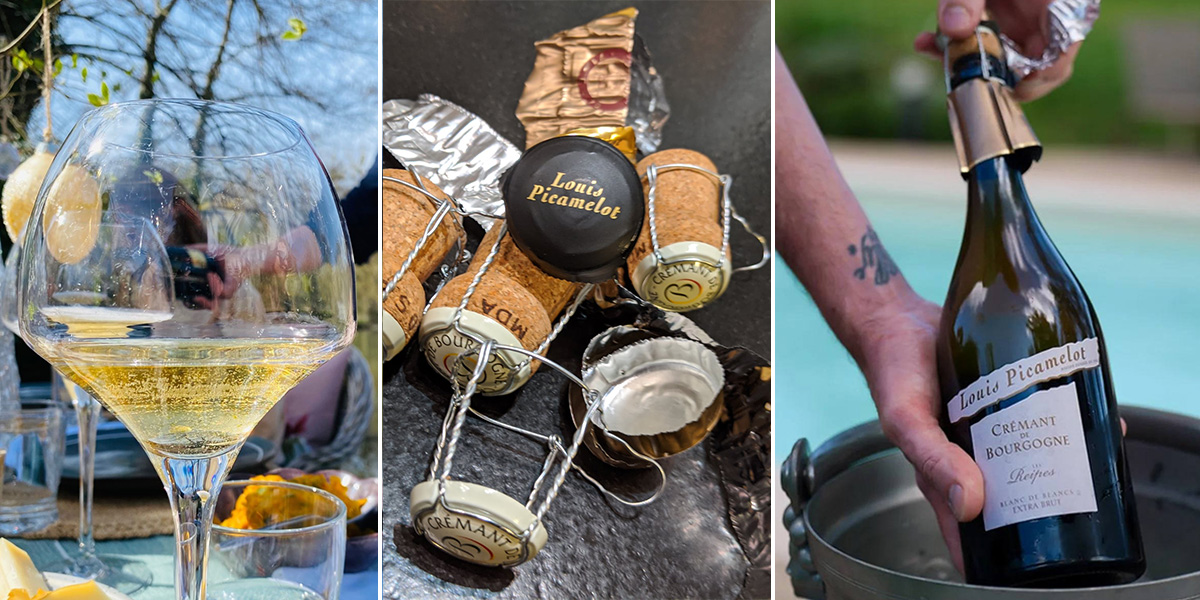The Appeal of Crémant de Bourgogne vs Prosecco and Their Differences
When the weather is warm and there’s something to celebrate, sparkling wines are a natural choice. In fact, even when the weather is cooler, there’s always an occasion that calls for something a little bit special with a fizz. Whether it’s Christmas, Thanksgiving or New Year, you’re sure to find bubbles in someone’s glass.
It’s something a little different from the usuallystill beverages we drink every day, and it can be very refreshing. But perhaps more than that, it is how things have developed over the last 300 years. In the fifteenth century, the first fizzy wines (which were made by accident) were not treated as special at all, and they might never have become widely known. But over the years, thanks to the work of monks, royalty, and, latterly, film stars, these beverages have come to represent all that is glamorous and opulent in life. Popping the cork on a bottle of fizz, of course, is a theatrical and memorable way to start any celebration, and has been the starting gun to many of the best nights we’ve had in Burgundy.
But perhaps on a more philosophical level, we see something of ourselves in the tiny bubbles struggling to rise to the surface – maybe we see our own hopes and dreams, our own struggle, and hope that we too will rise to the top eventually?
That may be a little far for some, but whatever the reason, the sparkling wine market is more diverse than ever. As a consumer, you need to know what the various types offer, and how they differ.
While Prosecco and Champagne remain popular, Crémant de Bourgogne is gaining recognition for its quality and value. (And as it’s from the land we call home – Burgundy it’s the one we prefer, of course!) A big part of the reason for Cremants growing popularity is that, unlike Prosecco, it is made in the Champagne style, giving it a depth and richness of flavor. And, it comes in at a much lower price point making it great for all occasions! So what exactly is Crémant, and how does it differ from Prosecco?

What’s the Difference Between Crémant de Bourgogne and Prosecco?
Crémant de Bourgogne is made from a variety of grapes, including Chardonnay, Pinot Noir (of course,) but also Pinot Gris and Gamay and it is made in the Champagne style. Prosecco, on the other hand, has to be made from a minimum of 85% Glera grape, which is a type of Italian grape, which ripens fairly late in the year and has a sort of strawcolor.
The production methods for Crémant and Champagne are similar, but there are important differences in the way they are made compared to Prosecco which is made using the Charmat or Tank Method. It was originally developed in 1895 by the Italian Federico Martinotti and further developed by the inventor Eugène Charmat in 1907 and is now named after the latter. Prosecco undergoes the secondary fermentation process in large tanks. In this method sugar and yeast are added to the base wine, which is then put into a stainless steel pressure tank for the secondary fermentation. As the yeast eats the sugar and ferments it releases CO2 which causes the tank to pressurize. Since the pressure has nowhere to go, it carbonates the wine. This process can be as short as 30 days. And there you have it…a sparkling wine!
Unlike Prosecco, Crémant (and Champagne) undergoes its second fermentation in the bottle. Aging time for Cremant is significantly longer than Prosecco. Crémant aged for a generous 24 months is labeled as ‘Eminent’, and even longer for the ‘Grand Eminents.’ Due to this process it tends to have more depth and richness than many Proseccos and has toasty overtones like those found in good Champagne. As the name suggests, Crémant has something quite ‘creamy’ about it, and is a little softer than Prosecco. It’s also versatile, making a great aperitif or a complement to a main meal. Rosé pairs well with sweet desserts like ice cream or red fruit tarts, and you can add some cassis for a sweeter drink.
Crémant wines can come from any of seven different regions in France, not just Burgundy, such as Crémant d’Alsace or Crémant de Bordeaux. Around 400 communes in the region produce Cremant de Bourgogne. It comes in different varieties: blanc, blanc de blanc, blanc de noirs, and rosé. The rosé variety is particularly interesting and is growing in popularity, similar to the rise of prosecco rosé, due to its relative sophistication.
When it comes to cost, there are significant differences. While Prosecco is typically the least expensive, Cremant, made in the Methode Champenoise, offers great value at much lower prices than Champagne. Whether you prefer Crémant, Prosecco, or Champagne, choose wisely and consider learning about the producer before purchasing. That’s why www.burgundywine.com by Elden Selections exists – to help you get to know the best small producers, and find the best deals on their wines.
The Best Crémant de Bourgogne from BurgundyWine.com
- For a great Crémant, consider the Domaine Borgeot Crémant de Bourgogne by brothers Pascal and Laurent Borgeot, and sold by Elden Selections. It is in fact produced in the same way as Champagne, but this is one that is kinder on the wallet, and made on a much more downtoearth scale – by one of our best small producers. Brothers Pascal and Laurent are the fourth generation of winemakers in their family – and a recent addition to the clan is Pascal’s daughter Julia, now a talented vigneron in her own right. The future is bright for this domaine!
- Louis Picamelot’s Crémant de Bourgogne ‘Les Reipes’. can also be found on www.burgundywine.com. This exceptional 1.55hectare terroir has been inscribed on the UNESCO World Heritage List since 2015. It is situated on the southfacing slopes of SaintAubin village at an altitude of about 350 meters in the Hautes Côtes de Beaune. The Cuvée, known as Les Reipes, represents Louis Picamelot’s interpretation of what a Blanc de Blancs Crémant should be. This wine is distinguished by its precision and great purity, which result from a pursuit of perfection and constant refinement. Visually, its color is bright, and the bubble exhibits finesse. The wine showcases freshness with citrus notes, complexity from the Chardonnay, and a subtle balance between delicacy and aromatic strength, making it suitable for meals as well as an aperitif. Elegant and generous, this Crémant also makes a perfect accompaniment for meals.
This Crémant de Bourgogne is crafted exclusively from 100% Chardonnay grapes. They are manually harvested when they are fully ripe and transported in small perforated cases to preserve the whole berries and prevent oxidation. The juice is extracted slowly by pneumatic press, retaining only the first presses, known as “Coeur de Cuvée”. 150 kg of pressed grapes yield 75 liters of base wine. The musts then rest in a custommade stainless steel vat with a special shape, where alcoholic fermentation occurs on fine lees. After fermentation, the resulting wine ages in the vat on fine lees for several months before being bottled with an addition of sugar and yeast blend. Secondary fermentation, referred to as “prise de mousse,” happens in the cellar where the bottles rest on racks for over 3 years at a temperature between 12 and 14°C. The bottles are then riddled, disgorged, and receive an addition of grape sugar (less than 6g/litre) called “liqueur d’expédition” (Extra Brut). Following the labeling and final closure of the bottle using a cork and metal cap, this Crémant de Bourgogne is typically ready to drink 6 months after the disgorging date stated on the back label.
France The Home of Sparkling Wine
France is often considered the home of sparkling wines and has a rich history in their production. The Champagne region perfected the technique, and now Burgundy is producing its own sparkling Crémants to compete with its more wellknown counterparts. We hope this article has whetted your appetite and that you’ll try some of our most favorite Crémant wines from Burgundy!
Why not book a holiday at Domaine de Cromey where you can taste these wonderful Crémant de Bourgogne in our unique and wellappointed tasting room? Discover more here. Read more blog articles on events, how to guides and our best producers at the Burgundywine.com blog. Check out our Domaine de Cromey blog for details of the amazing holidays you can have there, and the gastronomic delights on offer. And if you want more, join our Burgundy Wine Club!



